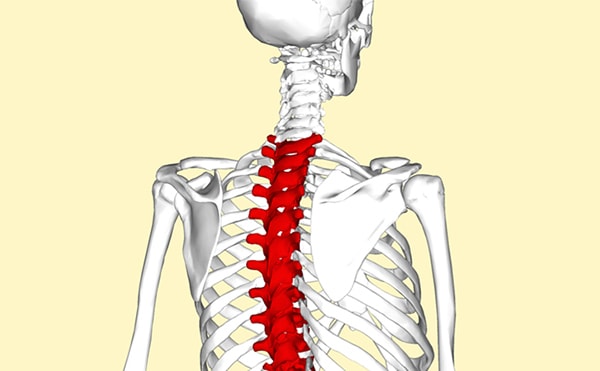T1 - T8 Spinal Cord Injuries
The first eight segments of the thoracic spine connect to the rib cage and control the trunk of the body.

The first eight segments of the thoracic spine connect to the rib cage and control the trunk of the body.
The thoracic region of the spinal column is made up of 12 segments referred to as T1 - T12. It is located in the middle of the spine between the cervical and lumbar levels. The 12 thoracic vertebrae which make up this section of the spine connect directly to the rib cage. Nerve roots exit the spinal column at each vertebral level of the spine. The nerves and spinal cord at the thoracic level communicate with the central parts of the body.Though thoracic spinal injuries are severe, they will rarely cause death.

The T1 vertebra is the first of twelve vertebrae of the thoracic spinal column. Since each descending vertebra is larger than the one before it to support the greater weight, thoracic vertebra T1 is the smallest vertebra of the thoracic region.
The T2 vertebra is the second vertebra in the thoracic spinal column. It is slightly larger than the T1 vertebra, but smaller than the T3 vertebra. The T2 vertebra has faceted sides that allow the vertebra to press up against the ribs.
The T3 vertebra is the third segment of the twelve thoracic vertebrae. Since it descends from the T2 vertebra, it is slightly larger than the two previous thoracic vertebrae.
The T4-T8 vertebrae make up the rest thoracic vertebrae before the thoracic vertebrae T9 - T12. With the exception of T4, which affects both the chest and abdomen, these vertebrae primarily control abdominal muscles. The T4 and T5 vertebrae are the most commonly injured thoracic vertebrae.
The thoracic vertebrae T1 is located in the upper part of the back. It’s the first section of the thoracic vertebrae, so it is located between the seventh cervical vertebra (C7) and T2.
The T2 vertebra is a member of the thoracic vertebrae column, located between the cervical vertebrae and the lumbar spinal vertebrae. As the second descending thoracic vertebra, the T2 vertebra is located below T1 and above T3.
The T3 vertebra is located between the T2 and T4 vertebrae. Approximately, the distance between the skull and the T3 vertebra is one-third of the way down the spinal column.
The T4 - T8 vertebrae are located between the T3 and T9 vertebrae and help to make up the thoracic vertebrae column. The thoracic vertebrae region slopes inward between the cervical and lumbar vertebrae regions. The T8 vertebrae can be located in the middle of this inward slope. The T8 vertebrae is at the same level as the xiphoid process — i.e. the small projection of the sternum.
The most common causes of thoracic spinal cord injuries are:
A T1 vertebra injury may result in moderate to severe neck pain and upper back pain. If the first rib is injured, there may be difficulty breathing.
Additional T1 vertebra pain symptoms may include numbness in the forearm or hand, or weakness in the hands, fingers and wrists.
Since the T2 vertebra helps control the heart, T2 vertebra pain symptoms may include chest pain, as well as heart trouble and a disruption in cardiac rhythm.
The T3 vertebra controls the lungs and bronchial tubes, as well as other chest muscles. Symptoms of a T3 vertebra injury include breathing difficulties, asthma, cough, as well as ailments such as bronchitis, influenza, and pneumonia

The T4 vertebra has nerves controlling the gallbladder and common duct, though it does affect the lungs and bronchial tubes additionally. As a result, T4 pain symptoms can show themselves through gallbladder trouble, gallstones, and jaundice.
Since the T5 - T8 vertebrae control abdominal muscles, pain symptoms for one of these vertebrae will manifest themselves through abdominal pain. The T5 and T6 vertebrae pain symptoms include digestion problems such as ulcers and heartburn. While T7 pain symptoms also include digestive ailments, the T7 and T8 vertebrae injury symptoms include fatigue, anemia, circulatory weakness, weakened immune system, and low blood, among others.
The T1-T8 vertebrae have similarities such as each of these thoracic vertebrae being directly attached to the rib cage and containing nerve roots that exit the spinal column at each vertebral level of the spine. However, the nerves of each thoracic vertebra level communicate with different sections of the body.
The T1-T4 thoracic sections control primarily chest muscles and organs, such as the heart and lungs. The T5 - T8 vertebrae affect the abdominal muscles, as well as some of the chest.
The T1-T8 vertebrae are also known as part of the twelve segments of the thoracic vertebrae region. Each can be referred individually as:
Injuries to the spinal cord tissue or nerve roots impact physical function according to their vertebral level. The cord and nerve tissues correlating to the upper thoracic vertebrae levels regulate the following:
Spinal cord injuries in the thoracic region are rare due to the rib cage protecting the spine. Much like cervical spine injuries, damage to the thoracic spine may be characterized as complete or incomplete, and may affect one or both sides of the body. The completeness of the spinal cord damage will determine how severe the injury truly is and how the patient can expect to recover.
Fractures of the thoracic spine generally occur towards the bottom of the thoracic region. Vertebrae T11 and T12 are more likely to be fractured than vertebrae T1-18. However, the T4 and T5 vertebrae are the most commonly injured thoracic vertebrae.
A fracture occurs when the vertebra collapses and causes the bone to break or splinter. This can be a result of trauma to the spinal vertebrae, which could result from a fall, violence, a car accident, or any event that will stress the spine out until it collapses. A thoracic fracture can also be the result of osteoporosis.
Misalignment, also known as subluxation, is when a vertebra is out of alignment. This can put pressure on spinal cord nerves, which can cause severe pain symptoms. Having misaligned thoracic vertebrae will produce the pain symptoms corresponding with the areas that each vertebra controls.
Treatment for thoracic spinal cord injuries is aimed at strengthening the body as a whole and preserving any remaining function that remains after the injury.
Current treatments available for spinal cord patients are:
An important part of the recovery and rehabilitation stage for thoracic spinal cord injury patients is physical therapy. Patients with T6-T12 spinal cord injuries should have a good ability to control their torso while sitting. Physical therapy will be crucial part of strengthening this ability, including using gait training and walking devices to help retain the strengthen any lower body function.
Psychiatrists are also important in the recovery journey for spinal cord injury patients. Mental health is a crucial part of rehabilitation, so these therapists are used to keep the patient in the best mind frame for recovery.
Thoracic spinal cord injuries are rare and only account for 10 - 15 percent of all spinal cord injuries. The thoracic spine is surrounded by the rib cage and it is much harder to damage the spinal cord in this area. Thoracic spinal cord injuries are typically less severe than injuries to the cervical spinal cord. The further down the spine the injury occurs, the greater chance for at least partial recovery.
Spinal cord injuries are traumatic for patients and their families. They cause disruptive changes to every aspect of your life and there is a lot of new information to navigate and understand. Our experts have collected everything in one place to help you learn more about your injury, locate doctors and treatment centers, find financial support, and get assistance navigating your next move.
Sponsored by Tampa personal injury lawyers at Swope, Rodante P.A. a Florida law firm located at 1234 E 5th Ave, Tampa, FL 33605.
The information provided by SpinalCord.com is not a substitute for professional medical advice, diagnosis, or treatment, see Disclaimer Policy.